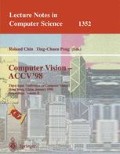Abstract
One of existing approaches to path planning problems uses a potential function to represent the topological structure of the free space. 1 Newtonian potential was used in [1] to represent object and obstacles in the 2D workspace wherein their boundaries are assumed to be uniformly charged. In this paper, the source distributions are extended to more general cases. It is shown that of the source distribution of a line segment can be uniform, linear or quadratic, the repulsion between two line segments can be evaluated analytically. Simulation results show that by properly adjusting the charge distribution along obstacle/object boundaries, path planning results can indeed be improved in terms of collision avoidance.
Preview
Unable to display preview. Download preview PDF.
References
J. H. Chuang and N. Ahuja, “An Analytically Tractable Potential Field Model of Free Space and Its Application in Obstacle Avoidance,” to appear in IEEE Trans. System, Man Cybern., vol. 28, Part B, no. 5, Oct. 1998.
R. A. Brooks and T. Lozano-Perez, “A subdivision algorithm in configuration space for findpath with rotation,” Int. Joint Conf. Artificial Intelligence, 1983.
J. T. Schwartz and M. Sharir, “On the piano movers'problem: 1. The case of a two-dimensional rigid polygonal body moving amidst polygonal barriers,” Comm. Pure Applied Math., vol. 36, pp. 345–398, 1983.
M. Herman, “Fast, three-dimensional, collision-free motion planning,” Proc. IEEE Int. Conf. Robotics Automat., 1986.
S. R. Maddila, “Decomposition algorithm for moving a ladder among rectangular obstacles,” Proc. IEEE Int. Conf. Robotics Automat., 1986.
S. Singh and M. D. Wagh, “Robot path planning using intersecting convex shapes,” Proc. IEEE Int. Conf. Robotics Automat., 1986.
D. T. Kuan, J. C. Zamiska, and R. A. Brooks, “Natural decomposition of free space for path planning,” Proc. IEEE Int. Conf. Robotics Automat., 1985.
O. Takahashi and R. J. Schilling, “Motion planning in a plane using generalized Voronoi diagrams,” IEEE Trans. Robotics Automat., vol. 5, no. 2, pp. 143–150, 1989.
C. E. Thorpe, “Path planning for a mobile robot,” Proc AAAI, 1984.
O. Khatib, “Real-time obstacle avoidance for manipulators and mobile robots,” Proc. IEEE Int. Conf. Robotics Automat., 1985.
P. Khosla and R. Volpe, “Superquadric artificial potentials for obstacle avoidance and approach,” Proc. IEEE Int. Conf. Robotics Automat., 1988.
Y. K. Hwang and N. Ahuja, “Potential field approach to path planning,” IEEE Trans. Robotics Automat., vol. 8, no. 1, pp. 23–32, 1992.
J. Miura and Y. Shirai “An uncertainty model of stereo vision and its application to vision-motion planning of robot,” Proc. 13th Int. Joint Conf. Artificial Intelligence, 1993.
Author information
Authors and Affiliations
Editor information
Rights and permissions
Copyright information
© 1997 Springer-Verlag Berlin Heidelberg
About this paper
Cite this paper
Chuang, JH., Tsai, CH., Tsai, WH., Yang, CY. (1997). Potential-based modeling of 2D regions using non-uniform source distributions. In: Chin, R., Pong, TC. (eds) Computer Vision — ACCV'98. ACCV 1998. Lecture Notes in Computer Science, vol 1352. Springer, Berlin, Heidelberg. https://doi.org/10.1007/3-540-63931-4_259
Download citation
DOI: https://doi.org/10.1007/3-540-63931-4_259
Published:
Publisher Name: Springer, Berlin, Heidelberg
Print ISBN: 978-3-540-63931-2
Online ISBN: 978-3-540-69670-4
eBook Packages: Springer Book Archive

